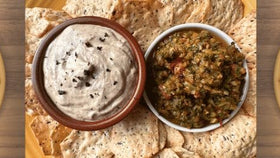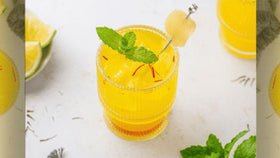How Do You Add Mica Powder To Soap?
At this time of year, everyone is scrambling to procure gifts for friends, family, neighbors, teachers, coworkers, and beyond. With an ever-growing list of giftees, it may seem a little overwhelming. Many folks turn to DIY projects for these occasions. Making your own soap is so easy and everyone loves receiving handmade gifts!
Creating your own soap allows you to customize scents, colors, shapes, and textures. One exciting way to elevate your soap-making game is by incorporating shimmering mica powder, also known as luster dust. In this guide, we'll take you through the steps of adding luster dust to your soap for a touch of festive sparkle.
How to Add Luster Dust to Soap: A Step-by-Step Guide for Stunning Results
Step 1: Choose Your Soap Base, Molds, and Essential Oils:
The foundation of your soap-making adventure begins with selecting the right soap base. For our project, we opted for two separate soaps—aloe soap and goat's milk soap. The clear aloe soap creates a stunning, almost glass-like appearance with the mica powder visible throughout. On the other hand, the white goat's milk soap provides a beautiful contrast, showcasing the luster dust on the outer layer.
Choose soap molds that suit your style – you can use molds designed specifically for for soap making or get creative with silicone baking molds or upcycled containers.
Enhance your soaps with a fragrance by choosing an essential oil. Since we were making holiday soaps, we went for a festive aromas of cranberry, cloves, cinnamon, and ponderosa pine. The right scent can complement the visual appeal of your soap for a themed multisensory experience.
Step 3: Incorporate Luster Dust:
There are various ways to add luster dust to your soap, and we recommend a combination approach for maximum effect:
- Drop it in simultaneously as you pour the soap.
- Paint the mold with luster dust.
- Add it to the bottom of the mold and then pour in the soap.
In our project, we began by dropping luster dust into the bottom of the soap molds and stirring in a few drops of alcohol (we used vodka). This helped distribute the mica powder evenly while somewhat marbling the colors and incorporating shine. Later, we painted the solidified molds with luster dust for an additional dazzling touch (step 10).
If you choose to drop it in as you pour the soap, you will do so in step 6.
Step 4: Prepare the Soap Base:
Determine the approximate ounces needed for your soap molds and cut your soap into 3/4-inch cubes. Using a microwave-safe, easy-pour measuring cup, add the soap and microwave in 30-second increments, stirring in between until fully liquified.
Step 5: Add Essential Oil and Pour:
Stir in several drops of your chosen essential oil (approximately 8 drops per ounce) into the liquified soap. This step not only adds a pleasant scent but also contributes to the overall sensory experience. Finally, pour the fragrant, liquified soap into your prepared molds until they are filled.
Step 6: Allow Soap to Cool and Solidify:
After pouring the liquified soap into the molds, exercise patience. Allow the soap to cool and solidify for a couple of hours. This crucial step ensures that the soap sets properly, preserving the integrity of your chosen design and maintaining the luster dust's shimmering effect.
Step 7: Remove Soap from Molds:
Once the soap has solidified, gently remove it from the molds. Take care not to rush this step to avoid any distortion or damage to the soap. The aloe soap, in particular, may resemble sand-blasted glass, showcasing the mica powder beautifully embedded throughout.
Step 8: Optional: Painting the Tops for Extra Shine:
If you want to add an extra layer of shine or detail to your soap, consider painting the tops. There are two methods you can use:
- Direct Powder Application: simply diip a soft, clean paint brush into the luster dust powder. Gently dust the powder onto the tops of your soap for a subtle shimmer.
- Liquid Paint for Finer Details: mix a small amount of luster dust with alcohol (vodka works well) to create a liquid paint. Use a fine brush to apply the liquid paint to specific areas of the soap for more intricate and detailed designs.
Step 9: Allow the Paint to Dry:
If you've chosen to paint the tops of your soap, allow the paint to dry completely before handling or packaging. The alcohol will evaporate quickly, so this shouldn't take long.
Step 10: Admire and Share Your Shimmering Creations:
Once the painted tops are dry, take a moment to admire your shimmering soap creations. Share your artistic endeavors with friends and family or consider packaging them as unique, handcrafted gifts for special occasions.
*****Adding luster dust to soap elevates the art of soap-making, creating a luxurious and visually appealing product. By following these additional steps, you ensure that your soaps not only look phenomenal but also have a professional finish. Embrace your creativity, experiment with different techniques, and enjoy the process of crafting personalized, shimmering soaps that are sure to impress. Happy soap-making!
Find an impressive selection of luster dust powders in our online shop.







Slofoodgroup
Author